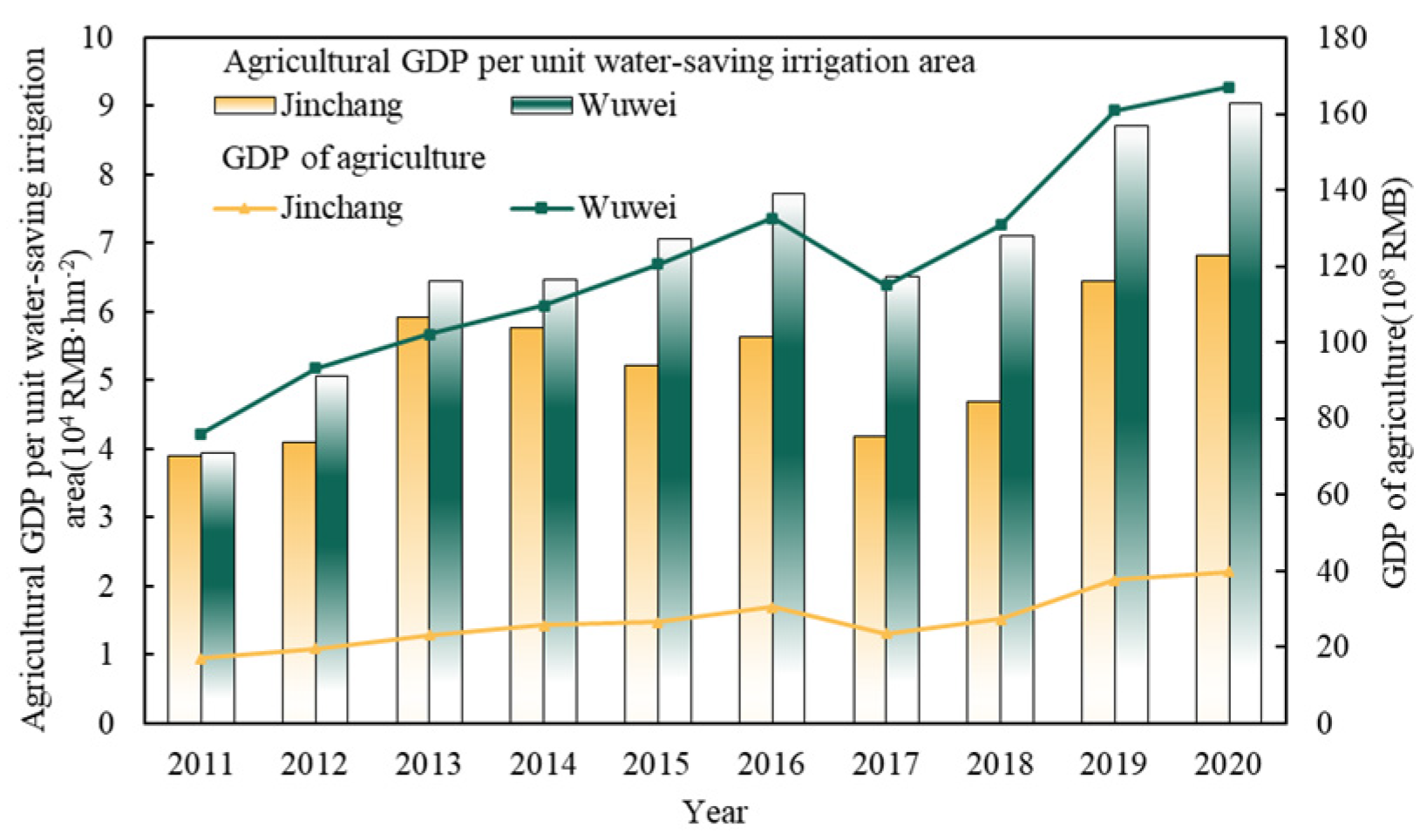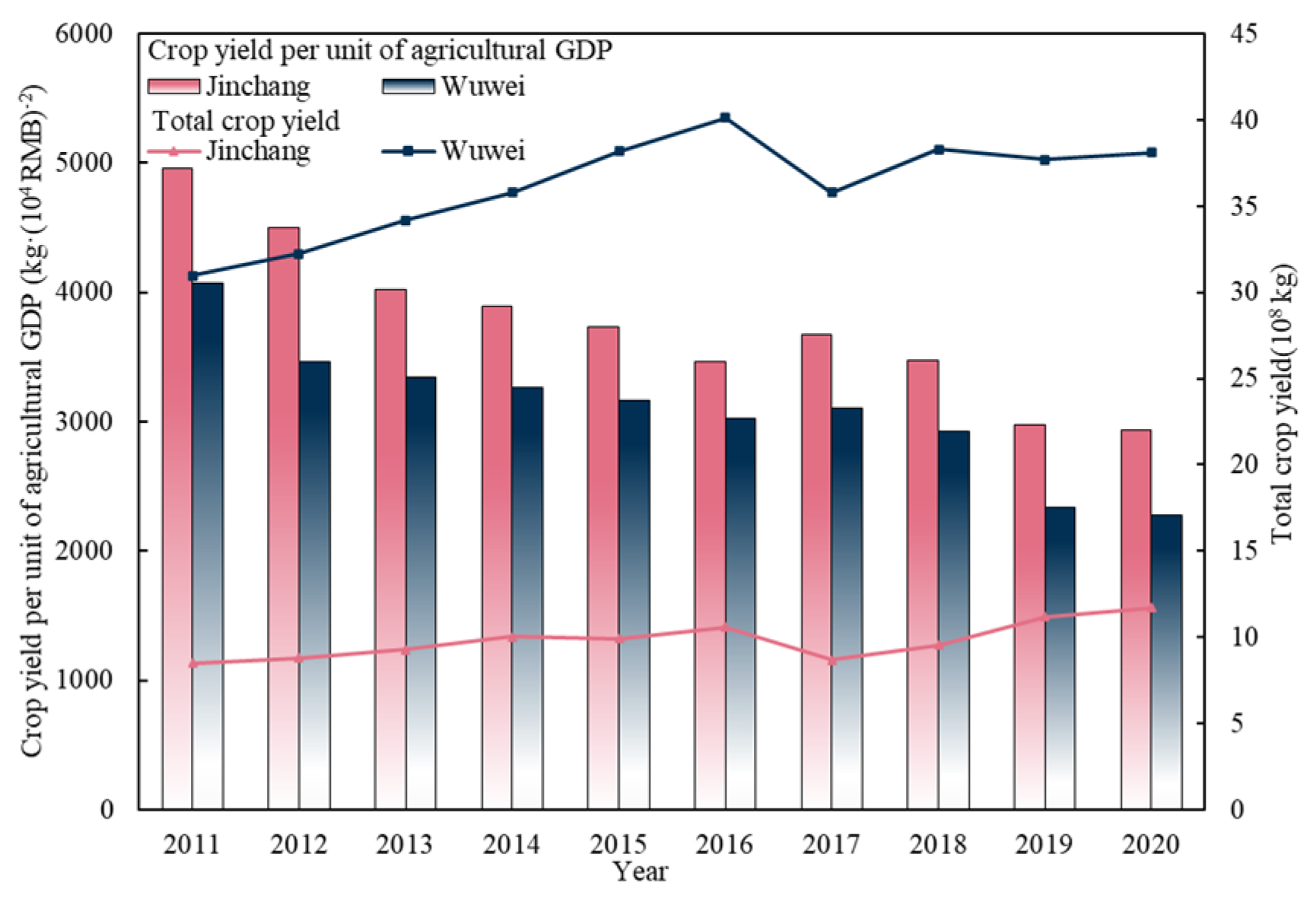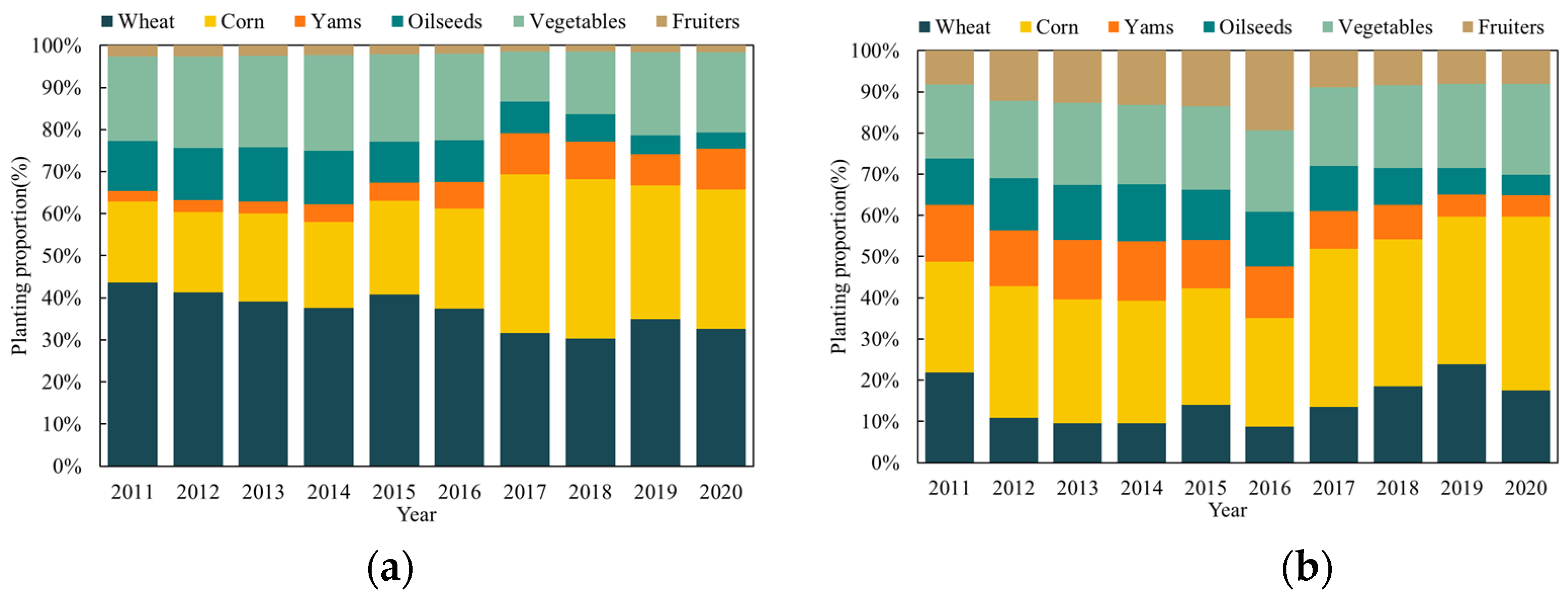Analyzing the Drivers of Agricultural Irrigation Water Demand in Water-Scarce Areas: A Comparative Study of Two Regions with Different Levels of Irrigated Agricultural Development
Abstract
:1. Introduction
2. Materials and Methods
2.1. Study Area
2.2. Data Description
2.3. Methods
2.3.1. Measurement of Irrigation Water Demand
- (1)
- Reference crop ET
- (2)
- Crop water demand
- (3)
- Effective precipitation
- (4)
- Net irrigation quota
2.3.2. LMDI Decomposition Model
3. Results and Discussion
3.1. Changes in Water Demand for Agricultural Irrigation
3.2. Decomposition Analysis
4. Conclusions
- (1)
- The optimization of planting structure and the implementation of water-saving irrigation practices to enhance food security;
- (2)
- The promotion and development of advanced water-saving irrigation technologies such as seepage irrigation and micro-sprinkler irrigation to conserve water;
- (3)
- The appropriate control of the proportion of grain crops versus cash crops;
- (4)
- The expansion of planting areas dedicated to low-water-consuming crops.
Author Contributions
Funding
Institutional Review Board Statement
Informed Consent Statement
Data Availability Statement
Conflicts of Interest
References
- Doll, P. Impact of climate change and variability on irrigation requirements: A global perspective. Clim. Chang. 2002, 54, 269–293. [Google Scholar] [CrossRef]
- Li, Y.T.; Zhang, Z.D.; Liu, S.L.; Cao, Z.; Ke, Q.; Chen, L.; Wang, G. Long-term responses in different karst agricultural production systems to farm management and climate change: A comparative prefecture-scale study in Southwest China. Agric. Ecosyst. Environ. 2023, 352, 108504. [Google Scholar] [CrossRef]
- Sun, S.K.; Wu, P.T.; Wang, Y.B.; Zhao, X.; Liu, J.; Zhang, X. The impacts of interannual climate variability and agricultural inputs on water footprint of crop production in an irrigation district of China. Sci. Total Environ. 2013, 444, 498–507. [Google Scholar] [CrossRef] [PubMed]
- Yang, L.; Yang, Y.; Feng, Z.; Zheng, Y. Effect of maize sowing area changes on agricultural water consumption from 2000 to 2010 in the West Liaohe Plain, China. J. Integr. Agric. 2016, 15, 1407–1416. [Google Scholar] [CrossRef]
- Zhang, Y.; Guo, Y.; Shen, Y.; Qi, Y.; Luo, J. Impact of planting structure changes on agricultural water requirement in North China Plain. Chin. J. Eco-Agric. 2020, 28, 1407–1416. (In Chinese) [Google Scholar]
- Gajic, L. Effect of irrigation regime on yield, harvest index and water productivity of soybean grown under different precipitation conditions in a temperate environment. Agric. Water Manag. 2018, 210, 224–231. [Google Scholar] [CrossRef]
- Jin, W.; Liu, S.S.; Zhang, K.; Kong, W. Influence of Agricultural Production Efficiency on Agricultural Water Consumption. J. Nat. Resour. 2018, 33, 1326–1339. (In Chinese) [Google Scholar]
- Nechifor, V.; Winning, M. Projecting irrigation water requirements across multiple socio-economic development futures—A global CGE assessment. Water Resour. Econ. 2017, 20, 16–30. [Google Scholar] [CrossRef]
- Zou, M.Z.; Kang, S.Z.; Niu, J.; Lu, H. A new technique to estimate regional irrigation water demand and driving factor effects using an improved SWAT model with LMDI factor decomposition in an arid basin. J. Clean. Prod. 2018, 185, 814–828. [Google Scholar] [CrossRef]
- Lopez-Nicolas, A.; Pulido-Velazquez, M.; Macian-Sorribes, H. Economic risk assessment of drought impacts on irrigated agriculture. J. Hydrol. 2017, 550, 580–589. [Google Scholar] [CrossRef]
- Xu, H.; Li, T.; Song, J. Estimation, driving factors, and regional differences of agricultural irrigation water rebound effect in arid areas: Examples of five provinces in northwestern China. Resour. Sci. 2017, 43, 1808–1820. (In Chinese) [Google Scholar]
- Feng, L.; Chen, B.; Hayat, T.; Alsaedi, A.; Ahmad, B. The driving force of water footprint under the rapid urbanization process: A structural decomposition analysis for Zhangye city in China. J. Clean. Prod. 2017, 163, S322–S328. [Google Scholar] [CrossRef]
- Lankford, B.; Pringle, C.; Mccosh, J.; Shabalala, M.; Hess, T.; Knox, J.W. Irrigation area, efficiency and water storage mediate the drought resilience of irrigated agriculture in a semi-arid catchment. Sci. Total Environ. 2023, 859, 160263. [Google Scholar] [CrossRef] [PubMed]
- Ma, W.J.; Meng, L.H.; Wei, F.L.; Opp, C.; Yang, D. Sensitive Factors Identification and Scenario Simulation of Water Demand in the Arid Agricultural Area Based on the Socio-Economic-Environment Nexus. Sustainability 2020, 12, 3996. [Google Scholar] [CrossRef]
- Guo, B.; Li, W.H.; Guo, J.Y.; Chen, C. Risk Assessment of Regional Irrigation Water Demand and Supply in an Arid Inland River Basin of Northwestern China. Sustainability 2015, 7, 12958–12973. [Google Scholar] [CrossRef]
- Zhang, L.; Li, M.N.; Zhang, J.X.; Chen, F.; Lei, Y. Quantifying the food-water nexus and key drivers in China’s agricultural sector. J. Clean. Prod. 2023, 415, 137794. [Google Scholar] [CrossRef]
- Xing, Z.K.; Ma, M.M.; Wei, Y.Q.; Zhang, X.; Yu, Z. A new agricultural drought index considering the irrigation water demand and water supply availability. Nat. Hazards 2020, 104, 2409–2429. [Google Scholar] [CrossRef]
- Moorhead, J.E.; Gowda, P.H.; Marek, T.H.; Porter, D.O.; Howell, T.A.; Singh, V.P.; Stewart, B.A. Use of crop-specific drought indices for determining irrigation demand in the texas high plains. Appl. Eng. Agric. 2013, 29, 905–916. [Google Scholar]
- Wang, L.; Xia, E.; Wei, Z.; Wang, W. Exploring the driving forces on sustainable energy and water use in China. Environ. Sci. Pollut. Res. 2022, 29, 7703–7720. [Google Scholar] [CrossRef]
- Zhao, C.F.; Chen, B. Driving Force Analysis of the Agricultural Water Footprint in China Based on the LMDI Method. Environ. Sci. Technol. 2014, 48, 12723–12731. [Google Scholar] [CrossRef]
- Li, C.; Jiang, T.T.; Luan, X.B.; Yin, Y.L.; Wu, P.; Wang, Y.; Sun, S.K. Determinants of agricultural water demand in China. J. Clean. Prod. 2021, 288, 125508. [Google Scholar] [CrossRef]
- Zeng, W.; He, J.; Qiu, Y.; Cao, X. Unravelling the Temporal-Spatial Distribution of the Agricultural Water Footprint in the Yangtze River Basin (YRB) of China. Water 2021, 13, 2562. [Google Scholar] [CrossRef]
- Zhang, S.; Su, X.; Singh, V.P.; Olaitan, A.O.; Xie, J. Logarithmic Mean Divisia Index (LMDI) decomposition analysis of changes in agricultural water use: A case study of the middle reaches of the Heihe River basin, China. Agric. Water Manag. 2018, 208, 422–430. [Google Scholar] [CrossRef]
- Liu, X.; Peng, X.; Bai, L.; Gao, C. Study on Driving Factors of Agricultural Water in Hebei Province Based on Water Footprint. Chin. J. Agric. Resour. Egional Plan. 2021, 42, 188–198. (In Chinese) [Google Scholar]
- Zeng, W.; Cao, X.C.; Huang, X.; Wu, M. Water resource use and driving forces analysis for crop production in China coupling irrigation and water footprint paradigms. Environ. Sci. Pollut. Res. 2022, 29, 36133–36146. [Google Scholar] [CrossRef]
- Zhang, H.; Wang, H. Spatial and temporal characteristics of water requirement and water deficit of wheat in Gansu Province from 1967 to 2017. Arid Land Geogr. 2007, 42, 1094–1104. (In Chinese) [Google Scholar]
- Zhang, H.; Wang, H.; Xu, C. Spatial and temporal characteristics of water requirement and water deficit of maize in Gansu Province from 1967 to 2017. Acta Ecol. Sin. 2015, 40, 1718–1730. (In Chinese) [Google Scholar]
- Ling, T. Impacts of Environment Change on Agricultural Water Consumption in Shiyang River Basin in Arid Region of Northwest China; Northwest A&F University: Shaanxi, China, 2007. (In Chinese) [Google Scholar]
- He, G. Analytical Study on Measurement and Analysis of Effective Utilization Coefficient of Gansu Agricultural Irrigation Water. Gansu Sci. Technol. 2015, 31, 49–50+80. (In Chinese) [Google Scholar]
- Banerjee, S.; Chatterjee, S.; Sarkar, S.; Jena, S. Projecting Future Crop Evapotranspiration and Irrigation Requirement of Potato in Lower Gangetic Plains of India using the CROPWAT 8.0 Model. Potato Res. 2016, 59, 313–327. [Google Scholar] [CrossRef]
- Geng, Q.L.; Zhao, Y.K.; Sun, S.K.; He, X.; Wang, D.; Wu, D.; Tian, Z. Spatio-temporal changes and its driving forces of irrigation water requirements for cotton in Xinjiang, China. Agric. Water Manag. 2023, 280, 108218. [Google Scholar] [CrossRef]
- Alghassab, M.; Khan, Z.A.; Altamimi, A.; Imran, M.; Alruwaili, F.F. Prospects of Hybrid Energy in Saudi Arabia, Exploring Irrigation Application in Shaqra. Sustainability 2022, 14, 5397. [Google Scholar] [CrossRef]
- Yetik, A.K.; Sen, B. Evaluation of the Impacts of Climate Change on Irrigation Requirements of Maize by CROPWAT Model. Gesunde Pflanz. 2023, 75, 1297–1305. [Google Scholar] [CrossRef]
- Smith, M. A Computer Program for Irrigation Planning and Management; FAO: Rome, Italy, 1992. [Google Scholar]
- Jin, Q.; Gui, D.; Gao, X.; Zeng, F.-J.; Xue, J.; Zhang, Q.-F. Water footprints of primary crop production in Xinjiang. Agric. Res. Arid Areas 2018, 36, 243–249. (In Chinese) [Google Scholar]
- Ang, B.W.; Liu, F.L. A new energy decomposition method: Perfect in decomposition and consistent in aggregation. Energy 2001, 26, 537–548. [Google Scholar] [CrossRef]
- Kaya, Y. Impact of carbon dioxide emission control on GNP growth: Interpretation of proposed scenarios. RIPCC Energy Ind. Subgr. Paris 1990. [Google Scholar]
- Wang, L.; Chen, F. Change in water-use efficiency of irrigated areas before and after integrated management in Shiyang River Basin. Acta Ecol. Sin. 2018, 38, 3692–3704. (In Chinese) [Google Scholar]
- Fang, G.; Chen, Y.; Li, Z. Variation in agricultural water demand and its attributions in the arid Tarim River Basin. J. Agric. Sci. 2018, 156, 301–311. [Google Scholar] [CrossRef]
- Juan, X.; Xiaoling, S. Decomposition of influencing factors on irrigation water requirement based on LMDI method. Trans. Chin. Soc. Agric. Eng. (Trans. CSAE) 2018, 33, 123–131. (In Chinese) [Google Scholar]
- Fang, L.; Wu, F.P.; Yu, Y.T.; Zhang, L. Irrigation technology and water rebound in China’s agricultural sector. J. Ind. Ecol. 2020, 24, 1088–1100. [Google Scholar] [CrossRef]







| Effect | Formula | Unit | Explanation |
|---|---|---|---|
| Technological progress effect | m3·kg−1 | This index is the amount of irrigation water needed for crop j per unit weight that represents technology level. | |
| Cultivation structure effect | % | This index is the proportion of the yield of crop j to the total yield of all 6 crops that represents planting structure. | |
| Water-saving management effect | % | This index is the proportion of the area of water-saving irrigation to the total acreage of all 6 crops that represents the level of water-saving management. | |
| Economic development effect | 104 RMB·ha−1 | This index is the ratio of agricultural GDP to the water-saving irrigated area and represents the level of economic development. | |
| Planting scale effect | ha | This index is the total acreage of 6 crops that represents the production scale. | |
| Consumption intensity effect | kg·(104 RMB)−1 | This index is the amount of yield needed per unit of agricultural GDP that represents the intensity of consumption. |
Disclaimer/Publisher’s Note: The statements, opinions and data contained in all publications are solely those of the individual author(s) and contributor(s) and not of MDPI and/or the editor(s). MDPI and/or the editor(s) disclaim responsibility for any injury to people or property resulting from any ideas, methods, instructions or products referred to in the content. |
© 2023 by the authors. Licensee MDPI, Basel, Switzerland. This article is an open access article distributed under the terms and conditions of the Creative Commons Attribution (CC BY) license (https://creativecommons.org/licenses/by/4.0/).
Share and Cite
Hua, M.; Zhou, Y.; Hao, C.; Yan, Q. Analyzing the Drivers of Agricultural Irrigation Water Demand in Water-Scarce Areas: A Comparative Study of Two Regions with Different Levels of Irrigated Agricultural Development. Sustainability 2023, 15, 14951. https://doi.org/10.3390/su152014951
Hua M, Zhou Y, Hao C, Yan Q. Analyzing the Drivers of Agricultural Irrigation Water Demand in Water-Scarce Areas: A Comparative Study of Two Regions with Different Levels of Irrigated Agricultural Development. Sustainability. 2023; 15(20):14951. https://doi.org/10.3390/su152014951
Chicago/Turabian StyleHua, Mengya, Yuyan Zhou, Cailian Hao, and Qiang Yan. 2023. "Analyzing the Drivers of Agricultural Irrigation Water Demand in Water-Scarce Areas: A Comparative Study of Two Regions with Different Levels of Irrigated Agricultural Development" Sustainability 15, no. 20: 14951. https://doi.org/10.3390/su152014951







